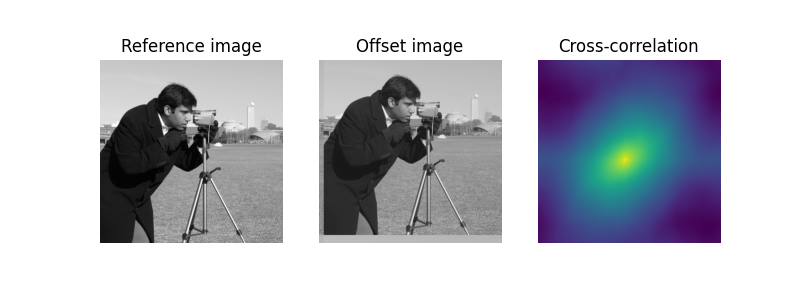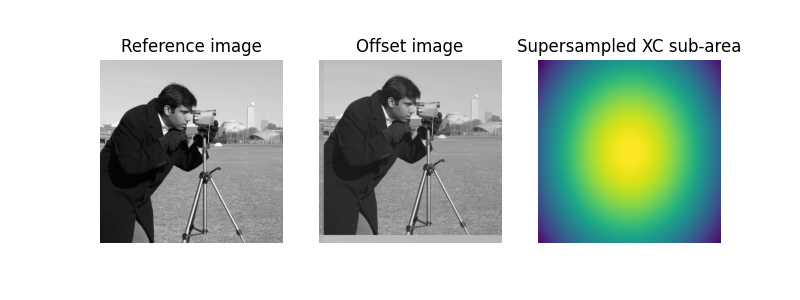注意
转到末尾以下载完整的示例代码。或者通过 Binder 在您的浏览器中运行此示例
图像配准#
在此示例中,我们使用相位互相关来识别两个大小相似的图像之间的相对位移。
phase_cross_correlation 函数在傅里叶空间中使用互相关,可以选择使用上采样矩阵乘法 DFT 来实现任意亚像素精度 [1]。
Known offset (y, x): (-22.4, 13.32)
Detected pixel offset (y, x): [ 22. -13.]
Detected subpixel offset (y, x): [ 22.4 -13.32]
import numpy as np
import matplotlib.pyplot as plt
from skimage import data
from skimage.registration import phase_cross_correlation
from skimage.registration._phase_cross_correlation import _upsampled_dft
from scipy.ndimage import fourier_shift
image = data.camera()
shift = (-22.4, 13.32)
# The shift corresponds to the pixel offset relative to the reference image
offset_image = fourier_shift(np.fft.fftn(image), shift)
offset_image = np.fft.ifftn(offset_image)
print(f'Known offset (y, x): {shift}')
# pixel precision first
shift, error, diffphase = phase_cross_correlation(image, offset_image)
fig = plt.figure(figsize=(8, 3))
ax1 = plt.subplot(1, 3, 1)
ax2 = plt.subplot(1, 3, 2, sharex=ax1, sharey=ax1)
ax3 = plt.subplot(1, 3, 3)
ax1.imshow(image, cmap='gray')
ax1.set_axis_off()
ax1.set_title('Reference image')
ax2.imshow(offset_image.real, cmap='gray')
ax2.set_axis_off()
ax2.set_title('Offset image')
# Show the output of a cross-correlation to show what the algorithm is
# doing behind the scenes
image_product = np.fft.fft2(image) * np.fft.fft2(offset_image).conj()
cc_image = np.fft.fftshift(np.fft.ifft2(image_product))
ax3.imshow(cc_image.real)
ax3.set_axis_off()
ax3.set_title("Cross-correlation")
plt.show()
print(f'Detected pixel offset (y, x): {shift}')
# subpixel precision
shift, error, diffphase = phase_cross_correlation(
image, offset_image, upsample_factor=100
)
fig = plt.figure(figsize=(8, 3))
ax1 = plt.subplot(1, 3, 1)
ax2 = plt.subplot(1, 3, 2, sharex=ax1, sharey=ax1)
ax3 = plt.subplot(1, 3, 3)
ax1.imshow(image, cmap='gray')
ax1.set_axis_off()
ax1.set_title('Reference image')
ax2.imshow(offset_image.real, cmap='gray')
ax2.set_axis_off()
ax2.set_title('Offset image')
# Calculate the upsampled DFT, again to show what the algorithm is doing
# behind the scenes. Constants correspond to calculated values in routine.
# See source code for details.
cc_image = _upsampled_dft(image_product, 150, 100, (shift * 100) + 75).conj()
ax3.imshow(cc_image.real)
ax3.set_axis_off()
ax3.set_title("Supersampled XC sub-area")
plt.show()
print(f'Detected subpixel offset (y, x): {shift}')
脚本的总运行时间:(0 分钟 1.014 秒)


